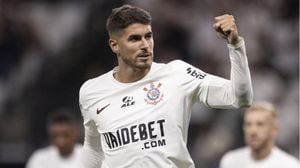Pierre Casiraghi, the youngest son of Carolina of Monaco and the late businessman Stefano Casiraghi, is making headlines following the announcement of his participation in the Admirals Cup, one of the most prestigious and perilous sailing regattas globally. The Admirals Cup is recognized as one of the premier competitions within the sailing domain, bringing together elite sailors and teams across various races.
Pierre will compete with the inaugural team of athletes representing the Yacht Club Monaco, making this the first time this team partakes in the event. The competition, organized by the Royal Ocean Racing Club—established by King George V in 1931—will take place from July 17 to August 1, 2025, on the Isle of Wight. Historically, the Admirals Cup first occurred in 1957 and was typically held biennially (in odd years) with national teams competing. After not being held in 2001, the last event occurred in 2003, rendering the 2025 edition its significant revival after more than two decades.
Reflecting on this news leads to memories of Stefano Casiraghi, Pierre’s father, who tragically passed away during a powerboat racing competition off Monte Carlo’s waters in 1990. Instead of retreating from danger, Pierre has embraced sailing as his way of honoring his late father’s legacy, cherishing the inherited passion for speed and the sea. The 37-year-old royal is more than ready for this formidable competition, which will challenge his endurance and physical prowess.
Notably, Pierre has participated as part of the Malizia team, engaging in various high-profile regattas, including the Vendée Globe and the America’s Cup. His dedication to the sport has positioned him as one of the most experienced sailors of his generation.
On another note, the relationship breakdown between Prince Harry and Meghan Markle with the Royal Family has come under scrutiny. Since January 2020, when the couple distanced themselves from royal duties, their children, Prince Archie and Princess Lilibet, have had limited interactions with their royal relatives, including Uncle Prince William and Aunt Kate Middleton. Yet, as Archie and Lilibet grow, their relationships could evolve.
Artificial intelligence offers insight on how these dynamics may shift. A prediction from the tool ChatGPT suggests, “Catherine’s relationship with Prince Archie and Princess Lilibet could be really special.” The AI believes Kate may play a significant supporting role as the children develop, providing guidance and warmth, particularly with her accessible personality.
Given Kate’s familial approach to her children, it’s feasible to envision her as a trusted figure for her nieces. The AI notes, “Kate has extensive experience raising her own children,” potentially enabling her to offer valuable advice on growing up publicly without losing authenticity.
Nevertheless, the history between Kate Middleton and Meghan might influence future interactions. With both families currently distanced due to multiple factors, any positive interactions or reunions will depend on overcoming existing challenges.
Adding to the royal family's current discourse is King Charles III's recent cancer diagnosis, sparking renewed interest concerning the line of succession to the British throne. The uncertainty surrounding his health has prompted public speculation about the monarchy's future. The succession plan is quite established, having evolved over time to guarantee the monarchy continues regardless of challenges.
The firstborn son of Charles and the late Lady Diana, Prince William, remains the first successor. His role as heir apparent is pivotal, serving as the monarchy's continuity and executing royal duties. Effectively preparing for this role is deemed significant as his time to take the crown approaches.
Following William are his three children, listed by birth order: Prince George, Princess Charlotte, and Prince Louis. Eleven-year-old George is the second heir and has already begun his integration within royal responsibilities, whereas Charlotte and Louis follow as third and fourth respectively. Remarkably, thanks to legislative changes made in 2013, the principle of male primogeniture no longer prevails, allowing Charlotte to maintain her rightful place among her brothers.
Prince Harry, having stepped back from royal duties and relocated to the United States with Meghan, remains the fifth heir alongside his children, Prince Archie and Princess Lilibet, located sixth and seventh respectively on the list.
Should William become unable to assume the throne, George stands next to take over, and if he too were unavailable, succession would fall to Charlotte, with Louis following. Only if none of William's children could perform royal duties would the crown revert to Harry and his descendants, which seems highly unlikely under current circumstances, especially with the family's already complex relationship.
Finally, as the world closely watches the intersections of personal and royal lives, tension lingers over the case of Marius Borg Høiby, one of the princess Mette-Marit’s sons, whose situation escalated with recent allegations and potential legal matters. The royal family's reputation has again been placed under scrutiny as incidents involving Borg accumulate, from previous accusations to current controversies stemming from unauthorized videos linked to public figures. The Norwegian media's coverage amplifies the situation, keeping interests high.
With the developments surrounding the Spanish Royal Family and the shifting tides within the British monarchy alike, society continues to observe how these connections, challenges, and legacies will shape contemporary royal narratives.



